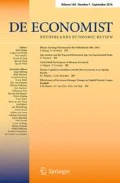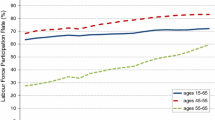Abstract
With a vignette experiment among Dutch managers we examine employers’ considerations in the decision to rehire employees after mandatory retirement. We specifically focus on the effects of the employee’s downward wage flexibility (i.e., the willingness to accept a lower wage) and contract flexibility (i.e., preference for a contract which allows flexible hours or employment). The results show that employers are strongly affected by employees who offer to work for a significantly lower wage, but not by the employees’ preference for a particular labor contract. Employers are overall quite disinclined to rehire employees after mandatory retirement, although large differences exist between employees. Part of these differences can be explained by employers having higher retirement age norms (i.e., the maximum age at which employers consider employees suited for work in their organization).


Similar content being viewed by others
Notes
We refer to the participants of our study as ‘employers’, although they are mainly line managers who have the authority to make employment decisions.
We define ‘downward wage flexibility’ as the willingness to accept a lower wage; we define ‘contract flexibility’ as a preference for a more flexible employment contract.
We truncated retirement age norm to avoid problems with outliers. This did not substantively alter our results.
By design, participants were shown five descriptions of employees who all wanted to continue in either a full-time, part-time, or on-call employment arrangement. The employment arrangement is mentioned in the vignette description, as well as in the question that serves as the dependent variable (see also Fig. 1).
Random slopes were considered for all vignette variables. Only those that significantly improved the model were included in the final models (Snijders and Bosker 1999).
The coefficients should thus be interpreted in terms of likelihood of rehiring, considering the dependent variable is measured on a scale from 1 to 11.
Model II is not a significant improvement over Model I (\(\chi ^{2}\)(9) = 15.63; p-value = 0.075), but this is mainly due to the variables ‘sector’ and ‘level of subordinates’ taking degrees of freedom while not explaining much.
Model III is a significant improvement over Model II (\(\chi ^{2}\)(4) = 18.52; p-value = 0.001).
References
Cahill, K. E., Giandrea, M. D., & Quinn, J. F. (2013). Bridge employment. In M. Wang (Ed.), The oxford handbook of retirement (pp. 293–310). Oxford: Oxford University Press.
Conen, W. S., Van Dalen, H. P., & Henkens, K. (2012a). Ageing and employers’ perceptions of labour costs and productivity: A survey among European employers. International Journal of Manpower, 33, 629–647.
Conen, W. S., Henkens, K., & Schippers, J. (2012b). Employers’ attitudes and actions towards the extension of working lives in Europe. International Journal of Manpower, 33, 648–665.
De Hek, P., & Van Vuuren, D. (2011). Are older workers overpaid? A literature review. International Tax and Public Finance, 18(4), 436–460.
Dingemans, E., & Henkens, K. (2014). Involuntary retirement, bridge employment, and satisfaction with life: A longitudinal investigation. Journal of Organizational Behavior, 35, 575–591.
Fugate, M., Kinicki, A. J., & Ashforth, B. E. (2004). Employability: A psycho-social construct, its dimensions, and applications. Journal of Vocational Behavior, 65, 14–38.
Gomez, R., Gunderson, M., & Luchak, A. (2002). Mandatory retirement: A constraint in transitions to retirement? Employee Relations, 24, 403–422.
Hallock, K. F. (2009). Job loss and the fraying of the implicit employment contract. The Journal of Economic Perspectives, 23(4), 69–93.
Heyma, A., van der Werff, S., Nauta, A., & van Sloten, G. (2014) What makes older job seekers attractive to employers? De Economist. doi:10.1007/s10645-014-9239-3.
Houseman, S. N. (2001). Why employers use flexible staffing arrangements: Evidence from an establishment survey. Industrial and Labor Relations Review, 55, 149–170.
Hutchens, R. M. (1986). Delayed payment contracts and a firm’s propensity to hire older workers. Journal of Labor Economics, 4, 439–457.
Hutchens, R. M. (2007). Job opportunities for older workers: When are jobs filled with external hires? In A. Mason & M. Yamaguchi (Eds.), Population change, labor markets, and sustainable growth: towards a new economic paradigm (pp. 133–159). Amsterdam: Elsevier.
Hutchens, R. M., & Grace-Martin, K. (2006). Employer willingness to permit phased retirement: Why are some more willing than others? Industrial and Labor Relations Review, 59, 525–546.
Kalleberg, A. L. (2000). Nonstandard employment relations: Part-time, temporary and contract work. Annual Review of Sociology, 26, 341–365.
Kantarci, T., & Van Soest, A. (2008). Gradual retirement: Preferences and limitations. De Economist, 156, 113–144.
Karpinska, K., Henkens, K., & Schippers, J. (2011). The recruitment of early retirees: A vignette study of the factors that affect managers’ decisions. Ageing & Society, 31, 570–589.
Karpinska, K., Henkens, K., & Schippers, J. (2013a). Hiring retirees: Impact of age norms and stereotypes. Journal of Managerial Psychology, 28, 886–906.
Karpinska, K., Henkens, K., & Schippers, J. (2013b). Retention of older workers: Impact of managers’ age norms and stereotypes. European Sociological Review, 29, 1323–1335.
Lazear, E. P. (1979). Why is there mandatory retirement? Journal of Political Economy, 87(6), 1261–1284.
Lynch, C. (2012). Retirement on the line: Age, work, and value in an American factory. Ithaca, NY: Cornell University Press.
Martin, G., Dymock, D., Billett, S., & Jonhson, G. (2014). In the name of meritocracy: Managers’ perceptions of policies and practices for training older workers. Ageing & Society, 34, 992–1018.
McEvoy, G. M., & Henderson, S. (2012). The retention of workers nearing retirement: A job embeddedness approach. Journal of Workplace Behavioral Health, 27, 250–271.
Mor-Barak, M. E. (1995). The meaning of work for older adults seeking employment: The generativity factor. The International Journal of Aging and Human Development, 41, 325–344.
OECD. (2006). Live longer, work longer. Paris: OECD publishing.
OECD (2014). Ageing and employment policies: Netherlands 2014. Paris: OECD publishing. http://dx.doi.org/10.1787/9789264208155-en.
Oude Mulders, J., Henkens, K., & Schippers, J. (2013). Organizations’ ways of employing early retirees: The role of age-based HR policies. The Gerontologist Advance Access first published on October 9, 2013. http://dx.doi.org/10.1093/geront/gnt114.
Pager, D., & Quillian, L. (2005). Walking the talk? What employers say versus what they do. American Sociological Review, 70, 355–380.
Pleau, R., & Shauman, K. (2012). Trends and correlates of post-retirement employment, 1977–2009. Human Relations, 66, 113–141.
Posthuma, R. A., & Campion, M. A. (2009). Age stereotypes in the workplace: Common stereotypes, moderators, and future research directions. Journal of Management, 35, 158–188.
Rossi, P. H., & Anderson, A. B. (1982). The factorial survey approach: An introduction. In P. H. Rossi & S. L. Nock (Eds.), Measuring social judgments: The factorial survey approach (pp. 15–67). Beverly Hills, CA: Sage.
Settersten, R. A., & Hagestad, G. O. (1996). What’s the latest? II. Cultural age deadlines for educational and work transitions. The Gerontologist, 36, 602–613.
Shultz, K. S. (2001). The new contingent workforce: Examining the bridge employment options of mature workers. International Journal of Organizational Theory and Behavior, 4, 247–258.
Siegenthaler, J. K., & Brenner, A. M. (2001). Flexible work schedules, older workers, and retirement. Journal of Aging & Social Policy, 12, 19–34.
Skirbekk, V. (2008). Age and productivity potential: A new approach based on ability levels and industry-wide task demand. Population and Development Review, 34(Supp.), 191–207.
Snijders, T. A. B., & Bosker, R. J. (1999). Multilevel analysis: An introduction to basic and advanced multilevel modeling. London: Sage.
Tourangeau, R., Rasinski, K. A., Bradburn, N., & D’Andrade, R. (1989). Carryover effects in attitude surveys. Public Opinion Quarterly, 53, 495–524.
Van Beek, K. W. H., Koopmans, C. C., & Van Praag, B. M. S. (1997). Shopping at the labour market: A real tale of fiction. European Economic Review, 41, 295–317.
Van Dalen, H. P., Henkens, K., & Schippers, J. (2010). Productivity of older workers: Perceptions of employers and employees. Population and Development Review, 36, 309–330.
Van Dalen, H. P., & Henkens, K. (2013). Dilemmas of downsizing during the Great Recession: Crisis strategies of European employers. De Economist, 161, 307–329.
Vickerstaff, S., Cox, J., & Keen, L. (2003). Employers and the management of retirement. Social Policy & Administration, 37, 271–287.
Wallander, L. (2009). 25 years of factorial surveys in sociology: A review. Social Science Research, 38, 505–520.
Acknowledgments
The authors gratefully acknowledge the helpful comments of an anonymous referee and the participants at the Feedback Forum of the Netherlands Interdisciplinary Demographic Institute. The LISS panel data were collected by CentERdata (Tilburg University, The Netherlands) through its MESS project funded by the Netherlands Organization for Scientific Research.
Author information
Authors and Affiliations
Corresponding author
Rights and permissions
About this article
Cite this article
Oude Mulders, J., van Dalen, H.P., Henkens, K. et al. How Likely are Employers to Rehire Older Workers After Mandatory Retirement? A Vignette Study Among Managers. De Economist 162, 415–431 (2014). https://doi.org/10.1007/s10645-014-9234-8
Published:
Issue Date:
DOI: https://doi.org/10.1007/s10645-014-9234-8




